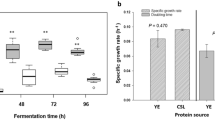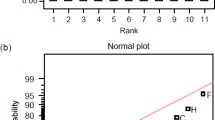Abstract
The production of microbial biomass in liquid media often represents an indispensable step in the research and development of bacterial and fungal strains. Costs of commercially prepared nutrient media or purified media components, however, can represent a significant hurdle to conducting research in locations where obtaining these products is difficult. A less expensive option for providing components essential to microbial growth in liquid culture is the use of extracts of fresh or dried plant products obtained by using hot water extraction techniques. A total of 13 plant extract-based media were prepared from a variety of plant fruits, pods or seeds of plant species including Allium cepa (red onion bulb), Phaseolus vulgaris (green bean pods), and Lens culinaris (lentil seeds). In shake flask tests, cell production by potato dry rot antagonist Pseudomonas fluorescens P22Y05 in plant extract-based media was generally statistically indistinguishable from that in commercially produced tryptic soy broth and nutrient broth as measured by optical density and colony forming units/ml produced (P ≤ 0.05, Fisher’s protected LSD). The efficacy of biomass produced in the best plant extract-based media or commercial media was equivalent in reducing Fusarium dry rot by 50–96 % compared to controls. In studies using a high-throughput microbioreactor, logarithmic growth of P22Y05 in plant extract-based media initiated in 3–5 h in most cases but specific growth rate and the time of maximum OD varied as did the maximum pH obtained in media. Nutrient analysis of selected media before and after cell growth indicated that nitrogen in the form of NH4 accumulated in culture supernatants, possibly due to unbalanced growth conditions brought on by a scarcity of simple sugars in the media tested. The potential of plant extract-based media to economically produce biomass of microbes active in reducing plant disease is considerable and deserves further research.


Similar content being viewed by others
References
Adiyaman T, Schisler DA, Slininger PJ, Sloan JM, Jackson MA, Rooney AP (2011) Selection of biocontrol agents of pink rot based on efficacy and growth kinetics index rankings. Plant Dis 95:24–30
Agil R, Gaget A, Gliwa J, Avis TJ, Willmore WG, Hosseinian F (2013) Lentils enhance probiotic growth in yogurt and provide added benefit of antioxidant protection. LWT-Food Sci Technol 50:45–49
Balamurugan S, Ahmed R, Gao A (2015) Survival of Shiga toxin-producing Escherichia coli in broth as influenced by pH, water activity and temperature. Lett Appl Microbiol 60:341–346
Burkhead KD, Schisler DA, Slininger PJ (1995) Bioautography shows antibiotic production by soil bacterial isolates antagonistic to fungal dry rot of potatoes. Soil Biol Biochem 27:1611–1616
Charalampopoulos D, Pandiella SS, Webb C (2002) Growth studies of potentially probiotic lactic acid bacteria in cereal-based substrates. J Appl Microbiol 92:851–859
Chaturvedi S, Randhawa HS, Chaturvedi VP, Khan ZU (1991) Efficacy of seed-based media for the mould-yeast conversion of Blastomyces dermatitidis. Mycopathologia 116:87–96
Chow PS, Landhäusser SM (2004) A method for routine measurements of total sugar and starch content in woody plant tissues. Tree Physiol 24:1129–1136
Diniz SC, Taciro MK, Gomez JGC, da Cruz Pradella JG (2004) High-cell-density cultivation of Pseudomonas putida IPT 046 and medium-chain-length polyhydroxyalkanoate production from sugarcane carbohydrates. Appl Biochem Biotechnol 119:51–69
Eckert JW, Ogawa JM (1985) The chemical control of postharvest diseases: subtropical and tropical fruits. Annu Rev Phytopathol 23:421–454
Gudiña EJ, Fernandes EC, Rodrigues AI, Teixeira JA, Rodrigues LR (2015) Biosurfactant production by Bacillus subtilis using corn steep liquor as culture medium. Front Microbiol 6:59
Huber R et al (2009) Robo-Lector: a novel platform for automated high-throughput cultivations in microtiter plates with high information content. Microb Cell Fact 8:42
Janisiewicz WJ, Korsten L (2002) Biological control of postharvest diseases of fruits. Annu Rev Phytopathol 40:411–441
Kensy F, Zang E, Faulhammer C, Tan RK, Büchs J (2009) Validation of a high-throughput fermentation system based on online monitoring of biomass and fluorescence in continuously shaken microtiter plates. Microb Cell Fact 8:31
Kobori NN, Mascarin GM, Jackson MA, Schisler DA (2015) Liquid culture production of microsclerotia and submerged conidia by Trichoderma harzianum active against damping-off disease caused by Rhizoctonia solani. Fungal Biol 119:179–190
Kunze M, Roth S, Gartz E, Büchs J (2014) Pitfalls in optical on-line monitoring for high-throughput screening of microbial systems. Microb Cell Fact 13:53
Marone A, Izzo G, Mentuccia L, Massini G, Paganin P, Rosa S, Varrone C, Signorini A (2014) Vegetable waste as substrate and source of suitable microflora for bio-hydrogen production. Renew Energy 68:6–13
Masi M, Evidente A, Meyer S, Nicholson J, Muñoz A (2014) Effect of strain and cultural conditions on the production of cytochalasin B by the potential mycoherbicide Pyrenophora semeniperda (Pleosporaceae, Pleosporales). Biocontrol Sci Technol 24:53–64
Masuko T, Minami A, Iwasaki N, Majima T, Nishimura SI, Lee YC (2005) Carbohydrate analysis by a phenol-sulfuric acid method in microplate format. Anal Biochem 339:69–72
Nunes CA (2012) Biological control of postharvest diseases of fruit. Eur J Plant Pathol 133:181–196
Pardo E, Ramos AJ, Sanchis V, Marín S (2005) Modelling of effects of water activity and temperature on germination and growth of ochratoxigenic isolates of Aspergillus ochraceus on a green coffee-based medium. Int J Food Microbiol 98:1–9
Pereg L, McMillan M (2015) Scoping the potential uses of beneficial microorganisms for increasing productivity in cotton cropping systems. Soil Biol Biochem 80:349–358
Plaga A, Stümpfel J, Fiedler HP (1989) Determination of carbohydrates in fermentation processes by high-performance liquid chromatography. Appl Microbiol Biotechnol 32:45–49
Sánchez-Chino X, Jiménez-Martínez C, Dávila-Ortiz G, Álvarez-González I, Madrigal-Bujaidar E (2015) Nutrient and nonnutrient components of legumes, and its chemopreventive activity: a review. Nutr Cancer 67:401–410
Sankh SN, Deshpande PS, Arvindekar AU (2011) Improvement of ethanol production using Saccharomyces cerevisiae by enhancement of biomass and nutrient supplementation. Appl Biochem Biotechnol 164:1237–1245
Schisler DA, Slininger PJ (1994) Selection and performance of bacterial strains for biologically controlling Fusarium dry rot of potatoes incited by Gibberella pulicaris. Plant Dis 78:251–255
Schisler DA, Slininger PJ, Bothast RJ (1997) Effects of antagonist cell concentration and two-strain mixtures on biological control of Fusarium dry rot of potatoes. Phytopathology 87:177–183
Slininger PJ, Schisler DA, Bothast RJ (1994) Two-dimensional liquid culture focusing: a method of selecting commercially promising microbial isolates with demonstrated biological control capability. In: Improving plant productivity with rhizosphere bacteria, 3rd international workshop on plant growth-promoting rhizobacteria, Adelaide, South Australia, pp 29–32
Slininger PJ, Dunlap CA, Schisler DA (2010) Polysaccharide benefits dry storage survival of the biocontrol agent Pseudomonas fluorescens S11:P:12 effective against several maladies of stored potatoes. Biocontrol Sci Technol 20:227–244
Spadaro D, Ciavorella A, Dianpeng Z, Garibaldi A, Gullino M (2010) Effect of culture media and pH on the biomass production and biocontrol efficacy of a Metschnikowia pulcherrima strain to be used as a biofungicide for postharvest disease control. Can J Microbiol 56:128–137
Srivastava R, Aragno M, Sharma AK (2010) Cow dung extract: a medium for the growth of pseudomonads enhancing their efficiency as biofertilizer and biocontrol agent in rice. Indian J Microbiol 50:349–354
Tang B, Qiu B, Huang S, Yang K, Bin L, Fu F, Yang H (2015) Distribution and mass transfer of dissolved oxygen in a multi-habitat membrane bioreactor. Bioresour Technol 182:323–328
Wong MH, Lay CC (1980) The comparison of soy-bean wastes, used tea leaves and sewage sludge for growing Chlorella pyrenoidosa. Environ Pollut Ser A Ecol Biol 23:247–259
Wu Q, Xu H, Ying H, Ouyang P (2010) Kinetic analysis and pH-shift control strategy for poly(γ-glutamic acid) production with Bacillus subtilis CGMCC 0833. Biochem Eng J 50:24–28
Zaid AM, Bonasera JM, Beer SV (2012) OEM: a new medium for rapid isolation of onion-pathogenic and onion-associated bacteria. J Microbiol Methods 91:520–526
Acknowledgments
The assistance of Maggie Hammar and Kristina Glenzinski in conducting experiments is greatly appreciated. Studies were made possible, in part, by funding and travel support provided by the Higher Education Commission (HEC), Pakistan.
Author information
Authors and Affiliations
Corresponding author
Additional information
Disclaimer: Mention of trade names or commercial products in this publication is solely for the purpose of providing specific information and does not imply recommendation or endorsement by the U.S. Department of Agriculture. USDA is an equal opportunity provider and employer.
Rights and permissions
About this article
Cite this article
Khalil, S., Ali, T.A., Skory, C. et al. Evaluation of economically feasible, natural plant extract-based microbiological media for producing biomass of the dry rot biocontrol strain Pseudomonas fluorescens P22Y05 in liquid culture. World J Microbiol Biotechnol 32, 25 (2016). https://doi.org/10.1007/s11274-015-1984-1
Received:
Accepted:
Published:
DOI: https://doi.org/10.1007/s11274-015-1984-1




